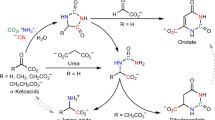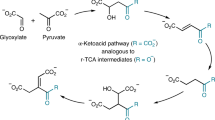Abstract
The first and highly conserved step in glutathione (GSH) biosynthesis is formation of γ-glutamyl cysteine by the enzyme glutamate-cysteine ligase (GshA). However, bioinformatic analysis revealed that many prokaryotic species that encode GSH-dependent proteins lack the gene for this enzyme. To understand how bacteria cope without gshA, we isolated Escherichia coli ΔgshA multigenic suppressors that accumulated physiological levels of GSH. Mutations in both proB and proA, the first two genes in L-proline biosynthesis, provided a new pathway for γ-glutamyl cysteine formation via the selective interception of ProB-bound γ-glutamyl phosphate by amino acid thiols, likely through an S-to-N acyl shift mechanism. Bioinformatic analysis suggested that the L-proline biosynthetic pathway may have a second role in γ-glutamyl cysteine formation in prokaryotes. Also, we showed that this mechanism could be exploited to generate cytoplasmic redox buffers bioorthogonal to GSH.
This is a preview of subscription content, access via your institution
Access options
Subscribe to this journal
Receive 12 print issues and online access
$259.00 per year
only $21.58 per issue
Buy this article
- Purchase on Springer Link
- Instant access to full article PDF
Prices may be subject to local taxes which are calculated during checkout




Similar content being viewed by others
References
Masip, L., Veeravalli, K. & Georgiou, G. The many faces of glutathione in bacteria. Antioxid. Redox Signal. 8, 753–762 (2006).
Brenot, A., King, K.Y., Janowiak, B., Griffith, O. & Caparon, M.G. Contribution of glutathione peroxidase to the virulence of Streptococcus pyogenes. Infect. Immun. 72, 408–413 (2004).
Newton, G.L. et al. Distribution of thiols in microorganisms: mycothiol is a major thiol in most actinomycetes. J. Bacteriol. 178, 1990–1995 (1996).
Newton, G.L. et al. Bacillithiol is an antioxidant thiol produced in Bacilli. Nat. Chem. Biol. 5, 625–627 (2009).
Fahey, R.C., Brown, W.C., Adams, W.B. & Worsham, M.B. Occurrence of glutathione in bacteria. J. Bacteriol. 133, 1126–1129 (1978).
Oden, K.L., Gladysheva, T.B. & Rosen, B.P. Arsenate reduction mediated by the plasmid-encoded ArsC protein is coupled to glutathione. Mol. Microbiol. 12, 301–306 (1994).
Smith, C.J., Deutch, A.H. & Rushlow, K.E. Purification and characteristics of a gamma-glutamyl kinase involved in Escherichia coli proline biosynthesis. J. Bacteriol. 157, 545–551 (1984).
Lehmann, C. et al. YbdK is a carboxylate-amine ligase with a gamma-glutamyl:Cysteine ligase activity: crystal structure and enzymatic assays. Proteins 56, 376–383 (2004).
Spector, D., Labarre, J. & Toledano, M.B. A genetic investigation of the essential role of glutathione: mutations in the proline biosynthesis pathway are the only suppressors of glutathione auxotrophy in yeast. J. Biol. Chem. 276, 7011–7016 (2001).
Park, S. & Imlay, J.A. High levels of intracellular cysteine promote oxidative DNA damage by driving the fenton reaction. J. Bacteriol. 185, 1942–1950 (2003).
Baich, A. Proline synthesis in Escherichia coli. A proline-inhibitable glutamic acid kinase. Biochim. Biophys. Acta 192, 462–467 (1969).
Rushlow, K.E., Deutch, A.H. & Smith, C.J. Identification of a mutation that relieves gamma-glutamyl kinase from allosteric feedback inhibition by proline. Gene 39, 109–112 (1985).
Omori, K., Suzuki, S., Imai, Y. & Komatsubara, S. Analysis of the mutant proBA operon from a proline-producing strain of Serratia marcescens. J. Gen. Microbiol. 138, 693–699 (1992).
Fujita, T. et al. Identification of regions of the tomato gamma-glutamyl kinase that are involved in allosteric regulation by proline. J. Biol. Chem. 278, 14203–14210 (2003).
Marco-Marín, C. et al. A novel two-domain architecture within the amino acid kinase enzyme family revealed by the crystal structure of Escherichia coli glutamate 5-kinase. J. Mol. Biol. 367, 1431–1446 (2007).
Hayzer, D.J. & Leisinger, T. The gene-enzyme relationships of proline biosynthesis in Escherichia coli. J. Gen. Microbiol. 118, 287–293 (1980).
Schnölzer, M. & Kent, S.B. Constructing proteins by dovetailing unprotected synthetic peptides: backbone-engineered HIV protease. Science 256, 221–225 (1992).
Pérez-Arellano, I., Rubio, V. & Cervera, J. Mapping active site residues in glutamate-5-kinase. The substrate glutamate and the feed-back inhibitor proline bind at overlapping sites. FEBS Lett. 580, 6247–6253 (2006).
Zhan, X. et al. Genetic analysis of disulfide isomerization in Escherichia coli: expression of DsbC is modulated by RNase E-dependent mRNA processing. J. Bacteriol. 186, 654–660 (2004).
Faulkner, M.J., Veeravalli, K., Gon, S., Georgiou, G. & Beckwith, J. Functional plasticity of a peroxidase allows evolution of diverse disulfide-reducing pathways. Proc. Natl. Acad. Sci. USA 105, 6735–6740 (2008).
Acknowledgements
We thank E. Stone and M. Faulkner for discussions. This work was supported by US National Institutes of Health grant GMO41883 to J.B. and US National Institutes of Health grant GM55090 to G.G.
Author information
Authors and Affiliations
Contributions
K.V. and G.G. designed research; K.V. and D.B. performed research; K.V., D.B., B.L.I., J.B. and G.G. analyzed data; K.V., D.B., B.L.I., J.B. and G.G. wrote the paper.
Corresponding author
Ethics declarations
Competing interests
The authors declare no competing financial interests.
Supplementary information
Supplementary Text and Figures
Supplementary Methods, Supplementary Figures 1–7 and Supplementary Tables 1–4 (PDF 598 kb)
Rights and permissions
About this article
Cite this article
Veeravalli, K., Boyd, D., Iverson, B. et al. Laboratory evolution of glutathione biosynthesis reveals natural compensatory pathways. Nat Chem Biol 7, 101–105 (2011). https://doi.org/10.1038/nchembio.499
Received:
Accepted:
Published:
Issue Date:
DOI: https://doi.org/10.1038/nchembio.499
This article is cited by
-
Prophage exotoxins enhance colonization fitness in epidemic scarlet fever-causing Streptococcus pyogenes
Nature Communications (2020)
-
The adaptive landscape of wildtype and glycosylation-deficient populations of the industrial yeast Pichia pastoris
BMC Genomics (2017)
-
Exploring chemoselective S-to-N acyl transfer reactions in synthesis and chemical biology
Nature Communications (2017)
-
Three-pathway combination for glutathione biosynthesis in Saccharomyces cerevisiae
Microbial Cell Factories (2015)
-
Role of glutathione in the oxidative stress response in the fungal pathogen Candida glabrata
Current Genetics (2013)



